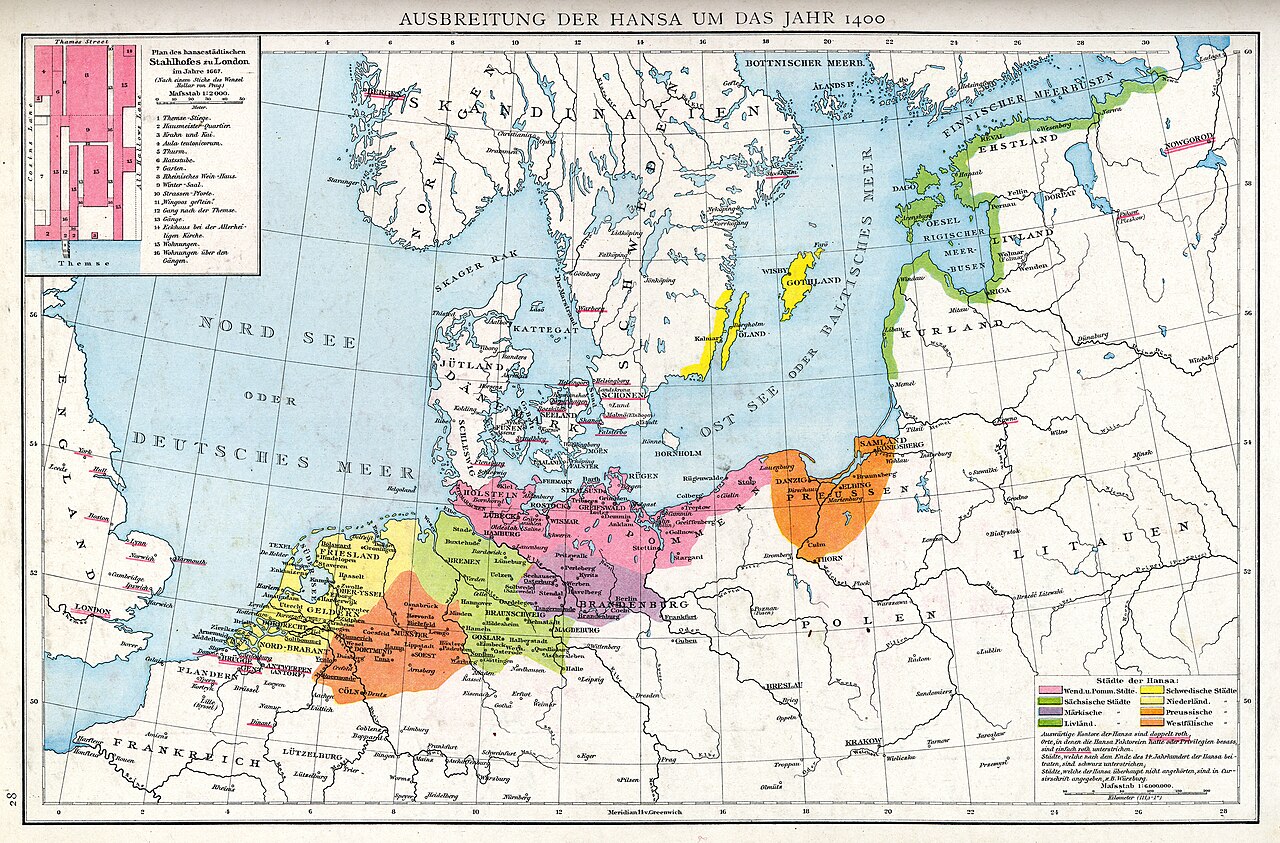
Northern Europe in the 1400s, showing the extent of the Hanseatic League
In dire diplomatic times it helps to make oneselves aware of the course of history, especially when it comes to questions of war and peace. Immanuel Kant envisioned souvereign republican nation states to cooperate internationally and this is what had already been foundation for by the Hanseatic League in medieval times.
The Hanseatic League[a] was a medieval commercial and defensive network of merchant guilds and market towns in Central and Northern Europe. Growing from a few North German towns in the late 12th century, the League expanded between the 13th and 15th centuries and ultimately encompassed nearly 200 settlements across eight modern-day countries, ranging from Tallinn in Estonia in the east, Bergen (Bjorgvin) in Norway to the North to the Netherlands in the west, and extended inland as far as Cologne, the Prussian regions and Kraków, Poland.
The League began as a collection of loosely associated groups of German traders and towns aiming to expand their commercial interests, including protection against robbery. Over time, these arrangements evolved into the League, offering traders toll privileges and protection on affiliated territory and trade routes. Economic interdependence and familial connections among merchant families led to deeper political integration and the reduction of trade barriers. This gradual process involved standardizing trade regulations among Hanseatic Cities.
During its time, the Hanseatic League dominated maritime trade in the North and Baltic Seas. It established a network of trading posts in numerous towns and cities, notably the Kontors in London (known as the Steelyard), Bruges, Bergen, and Novgorod, which became extraterritorial entities that enjoyed considerable legal autonomy. Hanseatic merchants, commonly referred to as Hansards, operated private companies and were known for their access to commodities, and enjoyed privileges and protections abroad. The League’s economic power enabled it to impose blockades and even wage war against kingdoms and principalities.
Even at its peak, the Hanseatic League remained a loosely aligned confederation of city-states. It lacked a permanent administrative body, a treasury, and a standing military force. In the 14th century, the Hanseatic League instated an irregular negotiating diet that operated based on deliberation and consensus. By the mid-16th century, these weak connections left the Hanseatic League vulnerable, and it gradually unraveled as members merged into other realms or departed, ultimately disintegrating in 1669.

The League used a variety of vessel types for shipping across the seas and navigating rivers. The most emblematic type was the cog. Expressing diversity in construction, it was depicted on Hanseatic seals and coats of arms. By the end of the Middle Ages, the cog was replaced by types like the hulk, which later gave way to larger carvel ships.
Now, at times of heated confrontations provoked by Western powers that culminated in the war over Ukraine, Russia and Germany should remind themselves of their historic bonds, especially the times of Catherine the Great, the German czaress of Russia almost 300 years ago.
In order to promote the cooperation, economically, but hopefully soon as well politically again, it may be fruitful to begin with the energy sector by opening Nordstream Two pipeline and for this reason found a new Russian – German Hanseatic League for Energy but not limit this to this interest of the two nations but also extend it to the cultural level.
After WWII French President Charles de Gaulle and West-German Chancellor Konrad Adenauer initiated the Montan Union, the European Coal and Steel Community (ECSC), often referred to as Montanunion, was a European Economic Union and a precursor to the EC. It gave all Member States access to coal and steel without having to pay customs duties. A particular novelty was the establishment of a High Authority, which was able to establish common arrangements for all Member States in the field of the coal and steel production industry. The ECSC was thus the first supranational organization ever; At first their supranational character was expressly mentioned in Article 9 of the ECSC Treaty of 18 April 1951. The founding members of the ECSC Treaty were Belgium, the Federal Republic of Germany, France, Italy, Luxembourg and the Netherlands. The ECSC Treaty, concluded for a period of 50 years, expired on 23 July 2002. He was not extended; Its regulatory power has now been added to the EC Treaty, since 2009 the Treaty on the Functioning of the European Union.
In the historic times the “capital” of the Hanseatic League inofficially has been Lübeck, but given the enclave status of Kaliningrad, one should consider make it rather Kaliningrad-Königsberg by giving it a speacial status under Russian sovereignity like Strasbourg is under French administration but a city for not only Germans and French, but all Europeans. Kaliningrad-Königsberg as the HQ for the new Hanseatic could play a similar role and serve as a bridge between East and West and by this through it’s economic as well as cultural significance be the main stabilising political factor ensuring lasting peace for the entire Eurasian Continents.